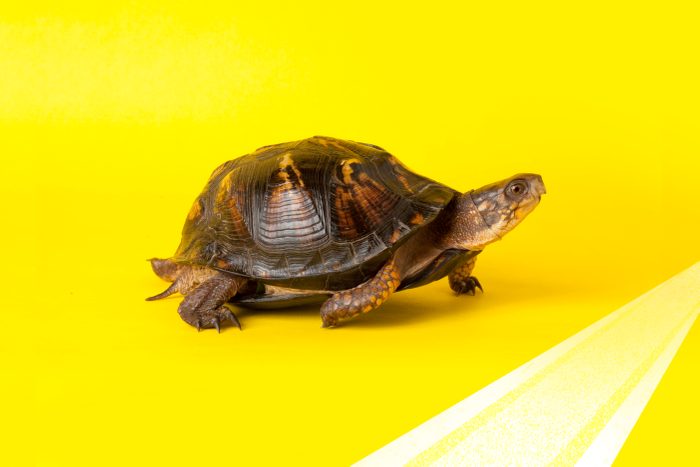
Slow and steady wins the race
We’ve all heard the saying about the slow-moving creatures who carry their house on their back. Some kinds of turtle are among the oldest living creatures on earth—certain species can live over 150 years. They’ve also been around for a really long time, since the age of the dinosaurs about 200 million years ago. Unfortunately, though, a recent report shows more than half of the approximately 350 current turtle species in the world are threatened with extinction. World Turtle Day was created 20 years ago to raise awareness of the need for protection for these amazing animals. Let’s look at a few of the coolest turtles who still roam the earth—although some might not for long. Turtles make up some of the wild animal species you didn’t know were endangered.
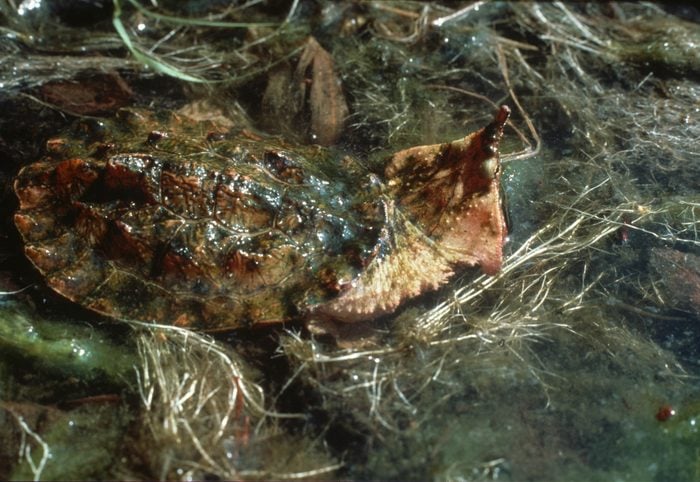
Matamata turtle
These bumpy, strangely shaped turtles look like a pile of rocks and leaves to help them blend into the murky shallow pools they inhabit in the Amazon of South America. This allows them to use a sneak attack on the unsuspecting fish that make up their diet. The matamata‘s flat and triangular head has a long snout at the end that the turtle can stick out of the water to breathe through, kind of like a snorkel. Matamata is fairly big, growing to a foot and half and weighing nearly 40 pounds. Scientists just discovered, in April 2020, there are actually two species of Matamata turtle, which evolved along different paths 13 million years ago. When the two species are counted separately, there are fewer turtles in each group, which may affect their conservation status. Their unique appearance also makes them vulnerable to the illegal wildlife trade.
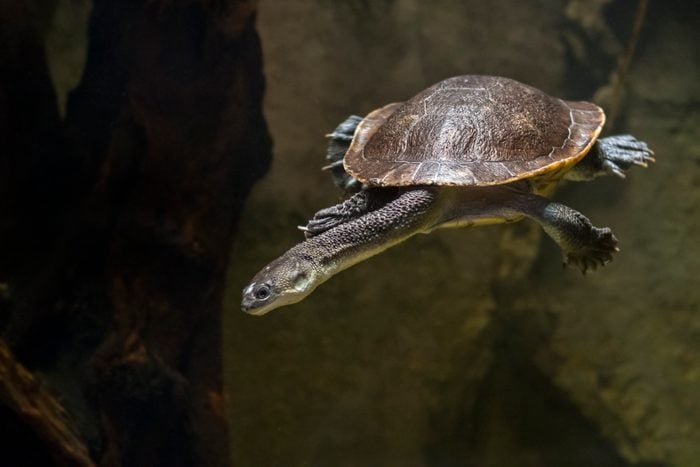
Roti Island snake-necked turtle
Talk about sticking your neck out: As its name suggests, the distinguishing feature of this turtle is its extremely long neck, which wraps around the side of its body for protection because it can’t fit in its shell! This critically endangered turtle from Indonesia is basically extinct in the wild, according to conservation group The Turtle Conservancy. The species was officially described by scientists in 1994, and since then the illegal pet trade expanded and led to its rapid decline. Plus, the conversion of the turtle’s wetland habitat to agriculture didn’t help, either. It’s possible that captive breeding programs could help return the species to the wild if its habitat was better protected.
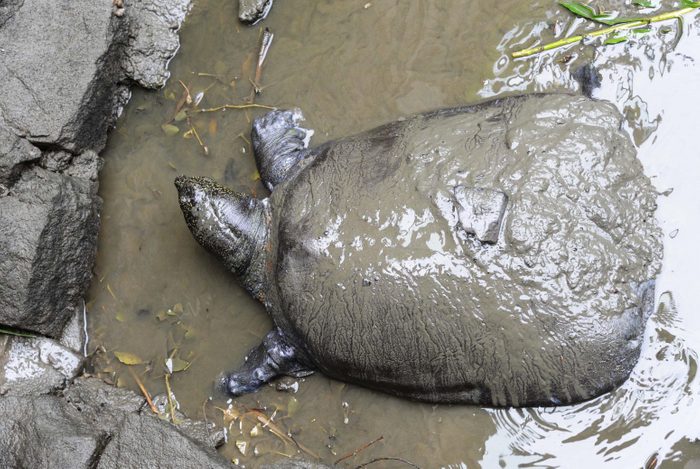
Yangtze giant softshell turtle
Softshell turtles are some of the strangest looking creatures on earth, and their lack of a hard shell almost seems to defeat the purpose of having a shell in the first place. They’re flattened, often quite large, and have a weird pointy nose. Although not all are threatened, one species of the softshell variety is the world’s rarest turtle on the planet, close to extinction with only three known individuals left in the world: the Yangtze giant softshell turtle. After an attempt at breeding, the last known female died at China’s Suzhou Zoo in 2019, leaving its partner, a male, and just a couple in the wild in Vietnam whose genders aren’t known. Scientists are making efforts, ironically with the help of local hunters, to see if any more of them might be out there.
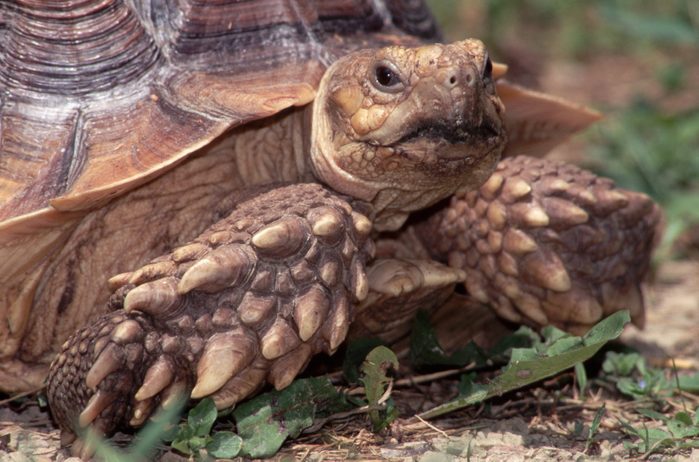
African spurred tortoise
What’s the difference between a turtle and a tortoise? A tortoise is a type of turtle that lives solely on land; they also tend to have a more dome-like shell. The African spurred tortoise might have scary-looking front legs—they’re covered in spurs, as its name suggests—and the animal is also the largest mainland tortoise (that is, they don’t come from an island, like the giant Galapagos tortoise), weighing up to 200 pounds. In their native Africa, where they’re listed as vulnerable, they like to burrow in the ground to escape the hot temperatures. But despite its heft, these creatures, also called Sulcata tortoises, have lively personalities that make them appealing as pets—although caring for them can be difficult so it’s not advised.
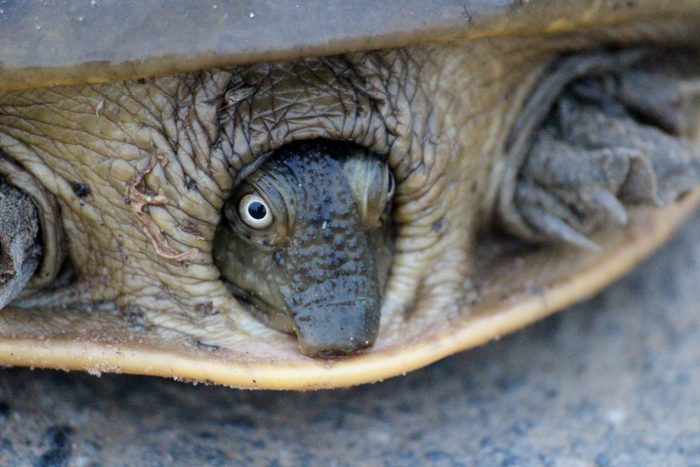
Indian flap shell turtle
When this odd-looking turtle retreats into its shell, flaps of skin come out to protect it. Along with its skinny snout, its wrinkly appearance makes it quite a sight. Like other distinctive turtles, this one is highly prized by poachers—although not currently endangered, the Indian flap shell turtle is in danger because of its demand in the illegal wildlife trade. It’s valued for its meat as well as for use in traditional medicine. In 2017, police caught poachers moving five tons of the medium-sized turtle in India. Luckily, with the help of veterinarians, some of those turtles were able to recover and be returned to the wild.
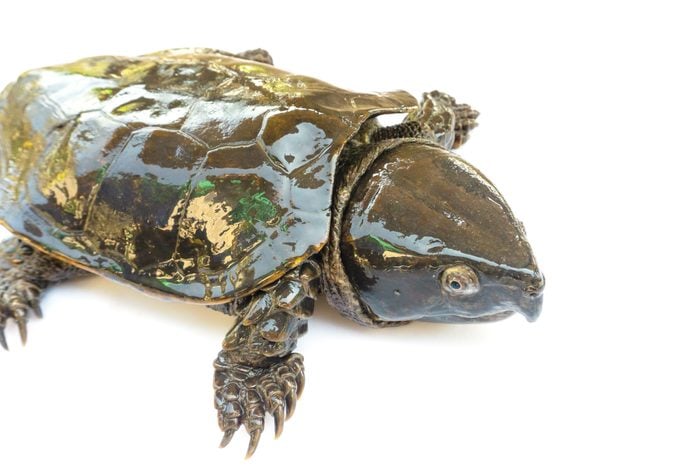
Big-headed turtle
This turtle is aptly named: Although its total size is pretty small (about seven inches long), its head is so big in relation to its body that the animal can’t retract it into its shell for protection. Its long tail is just about the same size as its body, and the turtle can use it to help prop itself up. The big-headed turtle isn’t a strong swimmer, but it has been known to climb trees! Endangered in its native Southeast Asia and southern China due to illegal trade, work is being done to conserve this unusual turtle. In 2013, the Prospect Park Zoo in New York City became the first zoo accredited by the Association of Zoos and Aquariums to successfully breed the turtle, and the zoo has since begun working with local conservation advocates in Myanmar, where the turtle lives in the wild. These endangered baby animals making a comeback will give you hope for the world.
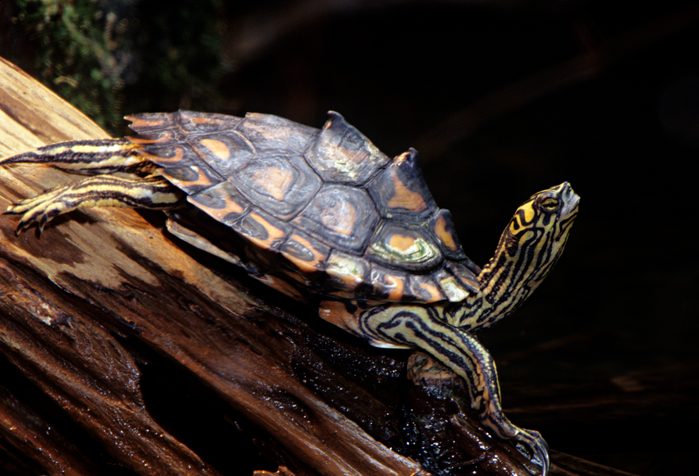
Yellow-blotched map turtle
These small but brightly colored turtles with distinctive spiny ridges on their shell, and yellow lines around its head and body, live only around the Pascagoula River in southeast Mississippi. Also called a yellow-blotched sawback, its shell features concentric rings that look like contour markings on a map, and the outer rim of its shell looks like a series of sharp teeth. It’s listed as a vulnerable species, but that’s actually a step up from its previous categorization of endangered. Human involvement in the turtle’s river habitat, including flood control, gravel mining, reservoir construction, and pollution, all contributed to its decline, which some conservation efforts have succeeded in stabilizing.
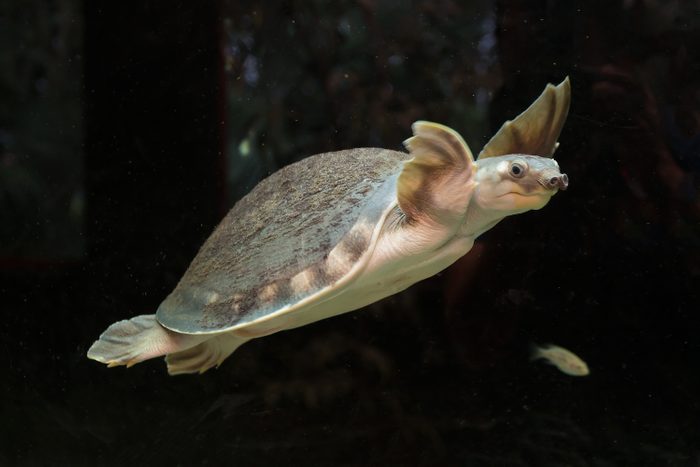
Pig-nosed turtle
As its name suggests, this endangered turtle has a very unique snout, which pokes out of the water to breathe while the rest of its body remains hidden below the surface. It also has flippers, similar to a sea turtle, and leathery skin like a soft-shell turtle. The underside of this turtle, called the plastron, is a lighter color, so it’s also camouflaged when looked at from below. The pig-nosed turtle is quite large, at over two feet long and up to 30 pounds. Also called the Fly River turtle, it’s native to warm freshwater in Papua New Guinea, parts of Australia, and Indonesia —in fact, it only leaves the water to nest.
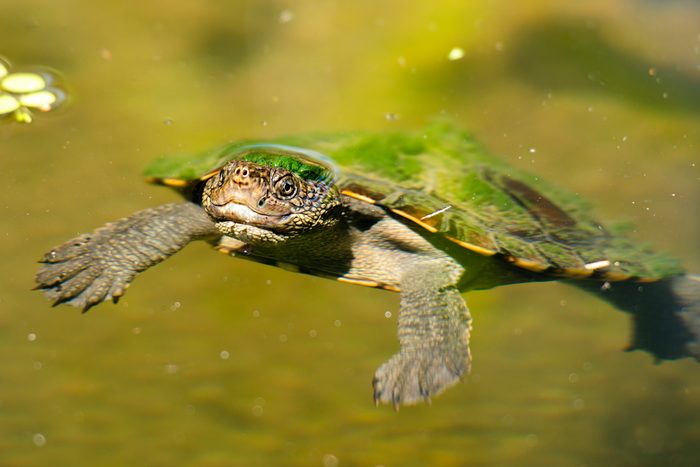
Mary River turtle
Known as the “punk rock turtle” for the green “hair” on its head—which is really algae—this crazy-looking turtle is sadly endangered. Living only in the Mary River in Queensland, Australia, this turtle has other strange features including two whisker-like spikes on its chin, large blue eyes, long claws, and the ability to breathe through its genitals—that is, the opening in its behind that’s used for excretion and reproduction. Oddly, this ability is actually the reason for the algae growth on the turtle’s head: It can stay submerged for up to three days, allowing the green grunge to grow.
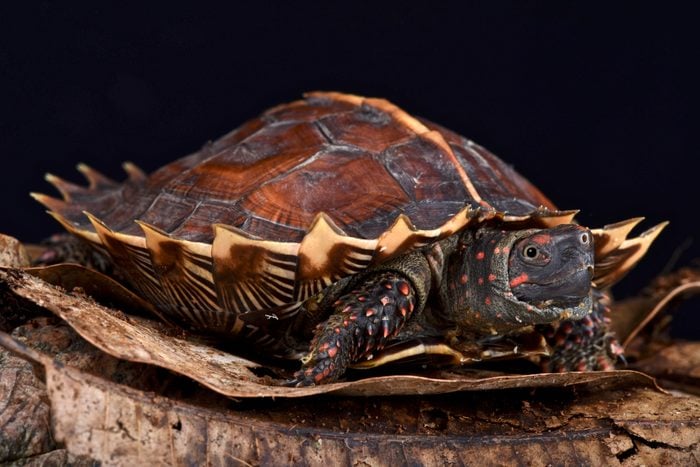
Spiny turtle
This endangered turtle is so named because when it’s young, it has pointy spikes on the outer rim of its shell as a defense mechanism and also to help it blend in with leaves on the forest floor. Its spikes, though, fade with age. Native to Thailand, the Malay Peninsula, and Indonesia, the spiny turtle lives near rainforest streams, but is vulnerable to the illegal wildlife trade for its unique shell, and also as food or pets. The International Union for Conservation of Nature (IUCN), though, notes that trade seems to have declined in Indonesia despite high demand. As with many other turtles, it’s hard to breed them in captivity, although some zoo programs have been successful.
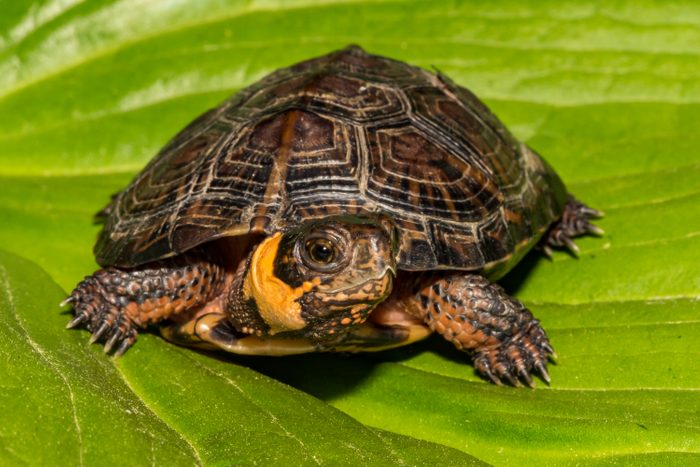
Bog turtle
Bog turtles might not be exactly exotic, as they live in the eastern United States, but they are one of the rarest turtles in the country. Listed as critically endangered as a whole by the IUCN (states may rank the status by their local population), the tiny turtles are a victim of habitat loss and illegal collecting. These animals also hold the distinction of being the smallest turtle in North America, at only four inches long. They love to live in the mud, but you might spot them by their bright orange patches on either side of their head. If you think you might have bog turtles on your property, contact your local branch of the U.S. Fish and Wildlife Service.
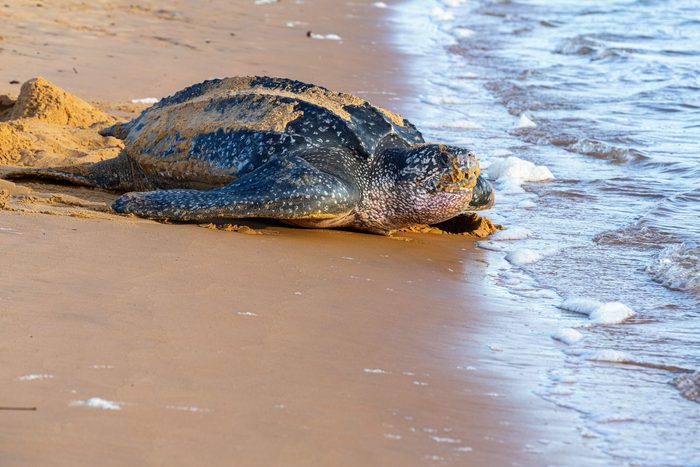
Leatherback sea turtle
These amazing ocean creatures are the largest turtle currently alive on Earth, and they undertake the longest migrations of any reptile, across both the Pacific and Atlantic Oceans. With a leathery back instead of a hard shell, which is more flexible for swimming, the huge leatherback can be up to 2,000 pounds and over six feet long. These vulnerable animals (endangered in the United States) help keep populations of jellyfish down—unfortunately, the turtles can also mistake plastic bags for their favorite food. Plus, the big creatures can get accidentally caught in fishing nets, and nesting areas on beaches have also been threatened by humans; their eggs may also be illegally collected. Turtles are some of the immortal animals that basically live forever.
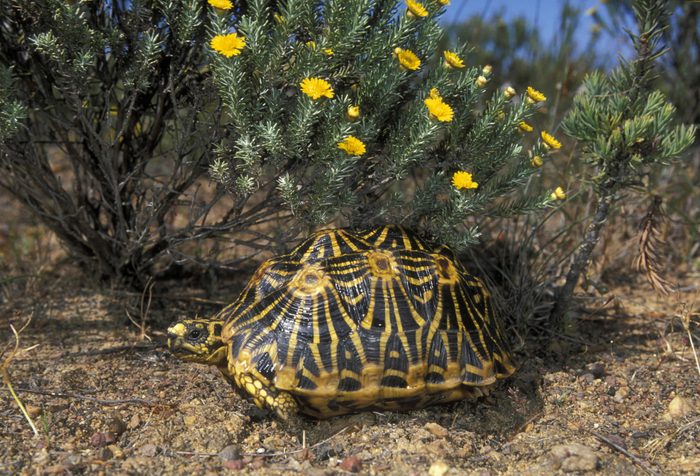
Geometric tortoise
This tiny, five inch-long tortoise has one of the coolest shells in existence, with an intricate black and yellow pattern that helps it blend in with its surroundings. But the geometric tortoise is also critically endangered. It lost around 90 percent of its habitat in the shrub-lands of its native Western Cape Province of South Africa due to agriculture and urbanization. The population of these cute animals was further diminished by widespread wildfires in the region. The Turtle Conservancy estimates there may be fewer than 1,000 individuals left in the wild, so they’ve set up a turtle preserve there to help save the species. Next, check out photos of the rarest animals on earth. And if you can’t get enough of turtles, bookmark these pictures of baby turtles to look at later.
